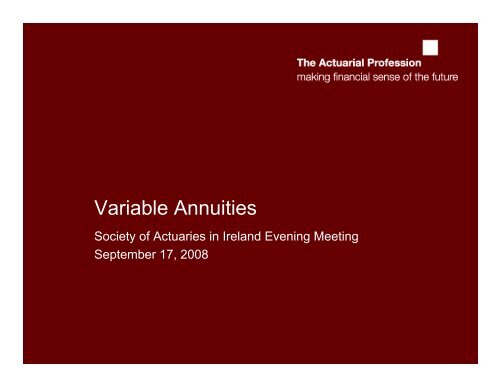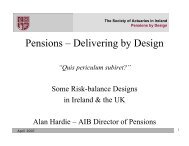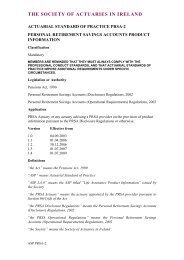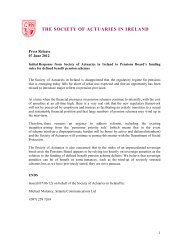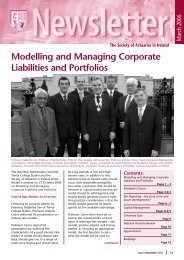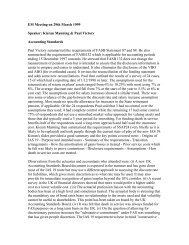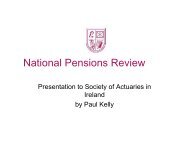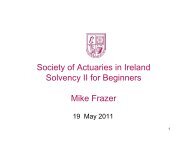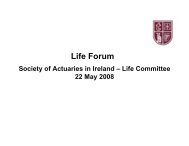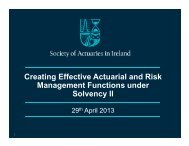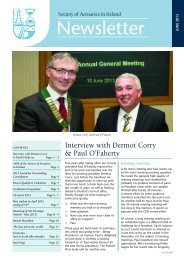Presentation - Society of Actuaries in Ireland
Presentation - Society of Actuaries in Ireland
Presentation - Society of Actuaries in Ireland
- No tags were found...
You also want an ePaper? Increase the reach of your titles
YUMPU automatically turns print PDFs into web optimized ePapers that Google loves.
Variable Annuities<strong>Society</strong> <strong>of</strong> <strong>Actuaries</strong> <strong>in</strong> <strong>Ireland</strong> Even<strong>in</strong>g Meet<strong>in</strong>gSeptember 17, 2008
Variable Annuities Work<strong>in</strong>g Party• Presented paper to Faculty and Institute <strong>in</strong> March 2008• Work<strong>in</strong>g Party members• Col<strong>in</strong> Ledlie• Dermot Corry• Gary F<strong>in</strong>kelste<strong>in</strong>• Alan Ritchie• Ken Su• Col<strong>in</strong> Wilson• Col<strong>in</strong> Ledlie, Dermot and Gary will present here today
Introduction (Section 1)• Variable Annuity• Can be a confus<strong>in</strong>g term• Orig<strong>in</strong>ated <strong>in</strong> the US• We def<strong>in</strong>ed it as “any unit-l<strong>in</strong>ked or managed fund vehicle which <strong>of</strong>fersoptional guarantee benefits as a choice for the customer”• Similar products available for many years – e.g. MaturityGuarantees Work<strong>in</strong>g Party <strong>in</strong> 1980• Fagan proposed a form <strong>of</strong> hedg<strong>in</strong>g for these types <strong>of</strong> guarantees <strong>in</strong>1977 but the 1980 Work<strong>in</strong>g Party took the view that there would bepractical disadvantages to this method• Advances <strong>in</strong> hedg<strong>in</strong>g techniques have been the key enabler <strong>in</strong>recent years
Agenda• Def<strong>in</strong>itions• Market Context• Sample Product• Customer Outcomes• Risk Management• Pric<strong>in</strong>g• Hedg<strong>in</strong>g and Market Risk Management• Reserv<strong>in</strong>g and Capital• Regulatory Issues• Discussion Po<strong>in</strong>ts
Def<strong>in</strong>itions (Section 2)• GMDB – Guarantee on death. May guarantee premiumpaid or the guarantee may <strong>in</strong>clude additional feature• GMAB – Accumulation benefit. As above withguarantee at surrender/maturity rather than death• GMIB – Income Benefit. Guarantees a m<strong>in</strong>mum <strong>in</strong>comeat annuitisation• GMWB – Withdrawal Benefit. Guarantees a m<strong>in</strong>imumwithdrawal from the fund each year. Fund can still besurrendered so different from a traditional annuity.• Variations <strong>of</strong> GMWB have withdrawal benefit payablefor life
UK Market Opportunity (Section 3)• Bridges the gaps left by the decl<strong>in</strong>e <strong>of</strong> with-pr<strong>of</strong>its and def<strong>in</strong>edbenefit pension schemes• Traditional annuities give strong guarantees but <strong>in</strong>flexible andresult <strong>in</strong> fixed <strong>in</strong>terest <strong>in</strong>vestment for up to 30 years• Drawdown (or ARFs <strong>in</strong> <strong>Ireland</strong>) allow <strong>in</strong>vestment <strong>in</strong> risky assetsbut no <strong>in</strong>come protection if market falls• UK market scale (2006) - £9.6bn annuities, £2.6bn drawdown• Face some regulatory challenges to product design
US Variable Annuity Sales ($bn)Source: NAVA, Milliman
Japanese Net VA Assets
European and Asian Developments• Launches <strong>in</strong> Korea, Hong Kong, Taiwan etc• Grow<strong>in</strong>g <strong>in</strong>terest <strong>in</strong> Cont<strong>in</strong>ental Europe• Aegon, Allianz, AXA, ING, Generali, Met Life, Munich Re (Ergo)• Others at the plann<strong>in</strong>g stage• UK market• Aegon, Hartford, L<strong>in</strong>coln, Met Life• Standard Life, Prudential and AXA have all announced thatthey are consider<strong>in</strong>g enter<strong>in</strong>g the market• Majority <strong>of</strong> above based <strong>in</strong> <strong>Ireland</strong> but activity also <strong>in</strong>Luxembourg• Germany chang<strong>in</strong>g regulations to allow VA bus<strong>in</strong>ess tobe written by domestic German companies
Sample Product Design (Section 5)• Guaranteed M<strong>in</strong>imum Withdrawal Benefit for life• 5% pa <strong>of</strong> orig<strong>in</strong>al premium guaranteed <strong>in</strong>come at age65 for life• Annual Step-Up (subject to 15% maximum to age 75)• 60% Equity Back<strong>in</strong>g Ratio• Charge for Guarantee 0.75% pa
Customer Outcomes (Section 6)• Stochastic Analysis <strong>of</strong> outcomes• Initially exam<strong>in</strong>e two selected scenarios – onebad (38) and one good (81)• Compare VA with <strong>in</strong>come drawdown• Then move on to probability distributions <strong>of</strong>outcomes• Treat<strong>in</strong>g Customers Fairly considerations
Simulation 38 – Fund Value and GuaranteeBase
Simulation 81 – Fund Value and GuaranteeBase
Probability Distribution – Income fromDrawdown
Probability Distribution – Income from VA
Treat<strong>in</strong>g customers fairly• Consider how the guarantee operates <strong>in</strong> a range <strong>of</strong>scenarios and appropriateness <strong>of</strong> product• Information requirements for the distributor to allowthem to understand the product• Review products post sale – cont<strong>in</strong>u<strong>in</strong>g to meet needs.Should they notify customer if guarantee is well out <strong>of</strong>the money?• Careful consideration <strong>of</strong> any ability to review chargesand/or benefits
Key Market Risks (Section 9)• Equity asset value movements (referred to as Delta)• Bond asset value movements (if bonds <strong>in</strong> portfolio)• Changes <strong>in</strong> <strong>in</strong>terest rates (Rho)• Equity market volatility (Vega)• Interest Rate volatility• Correlation between <strong>in</strong>terest rates and equity markets• Performance <strong>of</strong> funds compared with underly<strong>in</strong>g <strong>in</strong>dices(basis risk)• Pric<strong>in</strong>g is normally fixed for a period <strong>of</strong> time• Ideally changes with market conditions
Key Non-Market Risks• Lapse behaviour (or turn<strong>in</strong>g <strong>of</strong>f guarantee)• Mortality/Longevity• Funds chosen by the policyholder• Start <strong>of</strong> withdrawals• Amount <strong>of</strong> withdrawals per annum• Bus<strong>in</strong>ess mix – ages, genders etc
Pric<strong>in</strong>g (Section 7)• Key elements for market consistent pric<strong>in</strong>g• Economic scenario generator• Model to project guarantee <strong>in</strong>come and claimpayments• Assumptions on key variables• Mortality• Lapse, <strong>in</strong>clud<strong>in</strong>g dynamic behaviour if appropriate• Election rates• Etc.
Pric<strong>in</strong>g <strong>of</strong> Sample Product <strong>in</strong> paper• Market Consistent Cost at 30/06/07 = 0.49 %pa• Sensitivity• 1% absolute fall <strong>in</strong> <strong>in</strong>terest rates – 0.82 % pa• 25% relative <strong>in</strong>crease <strong>in</strong> equity vol – 0.67 % pa• Longevity 80% <strong>of</strong> central assumptions – 0.60 % pa• Defer withdrawals for 3 years – 0.38%• Flat withdrawals rather than dynamic – 0.37%
Price to the customer• Range <strong>of</strong> factors• Economic price• Competitive position• Perceived value <strong>of</strong> guarantee to customers• Will<strong>in</strong>gness to change price if markets change• Hedg<strong>in</strong>g strategy• Capital and reserv<strong>in</strong>g requirements• Sensitivity <strong>of</strong> the price to assumptions
Hedg<strong>in</strong>g and Market Risk Management(Section 10)• “Greeks” commonly used to describe the market risks• Delta - risk that UL fund falls <strong>in</strong> value• Delta = ∂V L /∂V A (where V A denotes value <strong>of</strong> UL fund)• Gamma – convexity <strong>of</strong> the liability option• Gamma = ∂∆/∂V A = ∂ 2 V L /∂V 2 A• Rho – Risk <strong>of</strong> <strong>in</strong>terest rate change• Rho = ∂V L /∂r (where r is the <strong>in</strong>terest rate)• Vega – Volatility <strong>of</strong> the underly<strong>in</strong>g assets• Vega = ∂V L /∂δ A
Hedg<strong>in</strong>g Techniques• Dynamic Hedg<strong>in</strong>g• Us<strong>in</strong>g “Greeks” select assets which will move <strong>in</strong> the same wayas the liability• Dynamically adjust hedge assets as value <strong>of</strong> “Greeks” changes• Depends on highly liquid assets with low trad<strong>in</strong>g costs• Static Hedg<strong>in</strong>g• Use over the counter options• Work well for simple guarantees such as GMAB• Exotic hedges needed for more complex guarantees• Some rebalanc<strong>in</strong>g almost certa<strong>in</strong>ly required – e.g. demographicvariations• Can be used as a core with a form <strong>of</strong> dynamic hedg<strong>in</strong>g for therebalanc<strong>in</strong>g
Market Risk Management – Re<strong>in</strong>surance• Grow<strong>in</strong>g market <strong>in</strong> re<strong>in</strong>surance• Risk appetite varies – market,mortality/longevity, lapse, election• Limited availability <strong>of</strong> full risk transfer• Provides alternative for smaller books or newentrants• Re<strong>in</strong>surance company may have m<strong>in</strong>imum sizeand other limitations
Impact <strong>of</strong> Hedg<strong>in</strong>g - Examples• We exam<strong>in</strong>e the implications <strong>of</strong> various marketstresses on the option value• With no hedg<strong>in</strong>g and different hedge strategies• Then look at longer term pr<strong>of</strong>it and lossdistribution projections• This gives us some possible <strong>in</strong>put for economiccapital
Instantaneous Stresses (Section 10)
Projection over time – Unhedged
Hedged
Measures <strong>of</strong> Economic Capital at RiskUnhedgedImmediate Stress(capital stra<strong>in</strong>/AV)5.8 %Cash FlowProjection(PVFP/AV)12.9 %Delta-Rho Hedge2.9 %2.5 %Delta-Rho-VegaHedge0.0%2.0%
Reserv<strong>in</strong>g and Capital (Section 8)• Stochastic approach needed to reserv<strong>in</strong>g• Most common approach <strong>in</strong> <strong>Ireland</strong> is to use ConditionalTail Expectation (CTE) approach• CTE approach adapted from the US method• This <strong>in</strong>volves project<strong>in</strong>g cashflows over the life <strong>of</strong> thepolicy for each scenario calculat<strong>in</strong>g reserve• CTE reserve is average <strong>of</strong> worst scenarios• Allow<strong>in</strong>g for hedg<strong>in</strong>g <strong>in</strong>volves nested stochasticprojections <strong>of</strong> pr<strong>of</strong>its for each scenario
Solvency Marg<strong>in</strong>• Products carry <strong>in</strong>vestment risk => 4% solvency marg<strong>in</strong>• May be possible to issue base UL product and rider asdist<strong>in</strong>ct products => 4% applies to rider only• F<strong>in</strong>ancial Regulator likes to see m<strong>in</strong>imum total capitalbased on CTE 90• Solvency II will lead to a change <strong>in</strong> approach• Easier to identify the impact <strong>of</strong> the different market aspects• Solvency II does not currently allow adequately forDynamic Hedg<strong>in</strong>g• However also poor at deal<strong>in</strong>g with basis risk, dynamiclapse, longevity etc
Regulatory Constra<strong>in</strong>ts (Section 11)• HMRC limits on <strong>in</strong>come drawdown (know asGAD limits) complicate market <strong>in</strong> the UK• Can limit <strong>in</strong>come payout when markets fall• Can force higher <strong>in</strong>come when markets rise• Undesirable and lobby<strong>in</strong>g for change• Not an issue <strong>in</strong> <strong>Ireland</strong> – though 3% ARFm<strong>in</strong>imum withdrawal could cause similar issues
Market ConditionsFTSE 10010 Year Equity ImpliedVolatility20 Year Swap RateSwaption Volatility(10 year option on 10 year swaps)Cost <strong>of</strong> Guarantee30/06/07660820.0%5.49%12.0%0.49 %07/03/08570027.1%4.90%11.4%0.96%
Discussion Topics (1)• Is the authors’ optimism regard<strong>in</strong>g theprospects for the product justified ?• Is there a genu<strong>in</strong>e consumer benefit from theseproducts ?• Will domestic companies succeed <strong>in</strong> this marketor will companies with established track recordselsewhere dom<strong>in</strong>ate ?
Discussion Topics (2)• Will hedg<strong>in</strong>g techniques perform as <strong>in</strong>tended <strong>in</strong>extreme market conditions ?• What changes to legislation would facilitatebetter outcomes for the customer (andacceptable outcomes for HMRC) ?• Are actuaries well equipped to develop andmarket these products ?


